Plum tree reaches a height of 13-15 meters. It bears fruit for about 20 years. There are varieties of fruit plants that take root well in the autumn in different regions and give the first crop for 4-5 years of life.
But for this you need to determine the planting location, take into account weather conditions, correctly plant a tree and apply the necessary fertilizers for growth and development.
Content
- 1 Benefits of Autumn Planting
- 2 Autumn Landing Time
- 3 Varieties
- 4 Optimal conditions for growing, site selection
- 5 Soil preparation
- 6 Buying planting material
- 7 Planting seedlings
- 8 Care after landing
- 9 Winter preparations
- 10 When to plant plum in spring or autumn
- 11 Features landing in the regions
- 12 Possible errors when planting a plum
Benefits of Autumn Planting
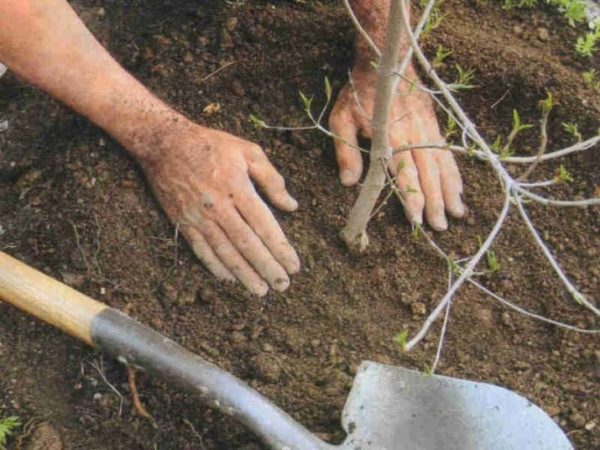 When planting a plum tree in the fall, the climatic zone, plum variety and terrain are taken into account. The farther south the region, the better young animals take root.
When planting a plum tree in the fall, the climatic zone, plum variety and terrain are taken into account. The farther south the region, the better young animals take root.
Benefits of Fall Plum Transplant:
- plants harden, become resistant to temperature extremes;
- the rhizome develops more intensively, rooting is faster, the tree does not spend energy on vegetation;
- Autumn trees are 2-3 weeks ahead of spring ones;
- enough time for work, in the spring with mass plantings of different crops, time is very limited;
- water is saved, because rains during this period are a frequent occurrence;
- trees take root easier and faster.
In the spring there is an intensive movement of juice along the branches. Root development slows down. If the rhizome is poorly developed in the hot summer, the plum can die. Autumn seedlings are much cheaper than those purchased in the spring.
Autumn Landing Time
Planting dates directly depend on the area of growth of trees, climatic and weather conditions. In the autumn, plum seedlings are planted 1.5 months before the soil freezes.
In the south of the country, the first frosts occur in mid-November, so you can plant a plum in October. These are Krasnodar and Stavropol Territories, Rostov and Astrakhan Regions.
Primorye is the second climatic zone. It snows here in September, but stable frosts come in November. Landing is done all October.
The Siberian region is famous for early frosts - in September. Therefore, it is recommended to plant young in August. In the suburbs, landing is carried out in late September - early October.
In a temperate climate (Irkutsk, Arkhangelsk, Tyumen regions) snow cover covers the land in late October. Trees are planted in early September. It is better to plant regional cold-resistant varieties, they will survive in the conditions to which they are adapted.
Varieties
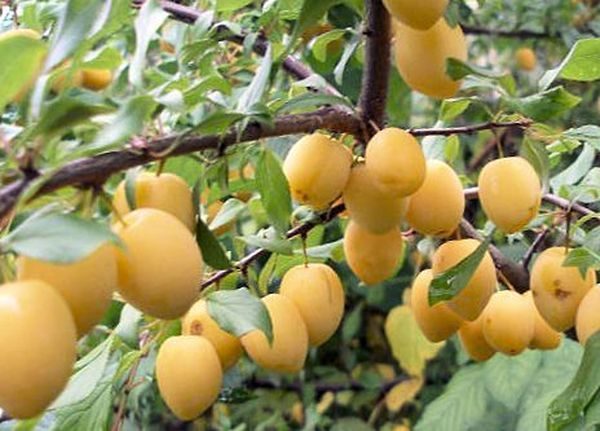 About 250 varieties of plum tree were bred. If earlier plum was considered a southern tree, now zoned hybrids with 100% survival have been bred. They give good crops both in the northern latitudes and in the southern regions.
About 250 varieties of plum tree were bred. If earlier plum was considered a southern tree, now zoned hybrids with 100% survival have been bred. They give good crops both in the northern latitudes and in the southern regions.
| Region | Name of plum varieties |
| The middle strip of Russia | Hungarian, Ussuriysk, Greengage, Chinese, Giant, Bluebird, Svetlana, Smolinka |
| Moscow region | Bogatyrskaya, Hungarian Korneevskaya, Volgograd, Peaceful, Early Zarechnaya |
| Ural and Siberia | Pearl of the Urals, Uyskaya, Uralskaya yellow, Kuyashskaya, Shershnevskaya, Chebarkulskaya, Aylinsky, Uvelskaya, Mikhalchik, Uralsky prunes, Pioneer, Vega, Ural golden, Pride of the Urals, Gift of Chemal, Golden Niva |
| South Country | July, Golden Ball, Early Zarechnaya, Skorodnaya, Souvenir of the East, Romain, Greengage, Svetlana, President, Express |
| Leningrad region | Red ball, Greengage collective farm, Tula black |
Plum Svetlana bred by coastal breeders, calmly tolerates frosts and gives stable crops. The fruits are yellow, round, one weighs 26-28 g. Flowering begins after May 10. Harvested in August. Sweet taste with sourness, the bone is separated from the pulp. One tree can produce up to 30 kg of plums. The first fruits are harvested for 5 years of life.
Giant - a quick-growing, high-yielding variety. Fruits appear for 3 years when planting a two-year-old tree. It has subspecies with burgundy, yellow-orange, purple fruit colors. The pulp is sweet. Harvesting in mid-September, fruits weighing up to 100 g.
Hungarian - Prunes are made from this species. Varieties: Italian, Voronezh, Michurinsky, Belorussian. Medium-sized trees up to 4 m in height. The first fruits grow at 6-7 years of age, large up to 5 cm in length, ellipsoidal. The color is lilac, purple, blue. Harvested in late August. Drought-resistant variety, life expectancy of 25-30 years.
The pearl of the Urals - winter-hardy plum, resistant to drought, characterized by high productivity. Chinese fruits 25 g in size, they have a dense, sweet pulp. Pearl bears fruit for 4 years of life, 17-19 kg of fruit from each tree.
Early - plums appear at 3 years of age. The tree has been living for 20 years. Harvest - up to 10 kg from one plant. There is a bad harvest every 3 years. The mass of one fruit is 20-30 g, round shape, yellow-orange color with a red barrel. The pulp is yellow, fragrant, sweet with sourness.
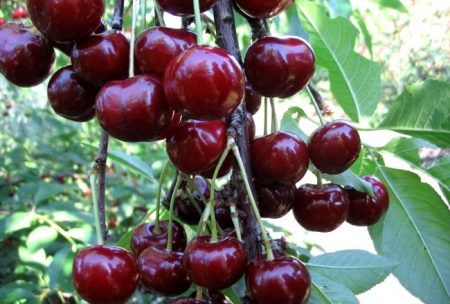 You may be interested in:
You may be interested in:Optimal conditions for growing, site selection
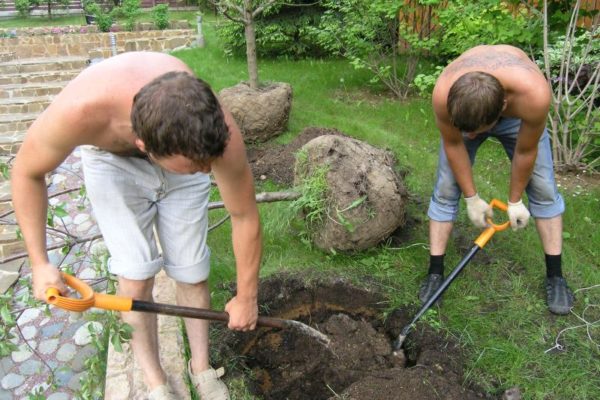 The first 4-6 years, the plum takes root, gives few fruits. The harvesting period is from 10 to 20 years of life. After 17-20 years, the crop begins to fall, the tree is aging.
The first 4-6 years, the plum takes root, gives few fruits. The harvesting period is from 10 to 20 years of life. After 17-20 years, the crop begins to fall, the tree is aging.
Plum loves light; it should be planted in a well-lit place. In the lowlands, cold air accumulates, this can harm the plant. Near the house or fence, the plum tree will be protected from the wind.
Plum is relatively drought-resistant, moisture-loving. You can not plant it in stagnant soil, the roots can rot. If groundwater is located at a depth of 1.5 m, then fluid drainage is required on the site.
Next to other fruit trees, a young tree may not survive. Adult plants take away all moisture and nutrients.
Soil preparation
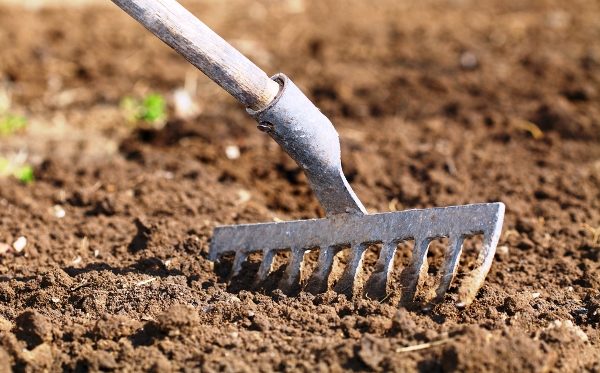 Primer is recommended for plums with a pH of 6.4-7. Clay and loamy soils are preferred. It successfully develops in soil with a high content of calcium, does not like acidic soils. If the acidic environment is added to the soil dolomite flour, wood ash, lime - per square 500 g of the substance.
Primer is recommended for plums with a pH of 6.4-7. Clay and loamy soils are preferred. It successfully develops in soil with a high content of calcium, does not like acidic soils. If the acidic environment is added to the soil dolomite flour, wood ash, lime - per square 500 g of the substance.
The composition of the soil for the pit:
- top layer of the earth;
- potassium - 15 g;
- humus - 12-15 kg;
- superphosphate - 70 g;
- river sand;
- gravel for drainage.
After digging a hole with a depth of 50 cm and so much width, put a peg and pour the prepared nutrient mixture.
Buying planting material
It is better to buy seedlings in specialized nurseries. They grow trees with grafted varietal stalks. These seedlings begin to bloom and bear fruit earlier. Choose material without rotten roots to look healthy. Young animals grown in spring are not suitable for autumn transplantation.
Criterias of choice:
- total height up to 1.2-1.5 m;
- the trunk is flat, whole bark;
- what kind - self-fertile or self-infertile;
- trunk length to branches - 55 cm;
- life span from one to two years;
- trunk grasp at a height of 12 cm from the vaccination site 1.5-2 cm;
- roots - 5-7 pieces with a length of 20 cm.
A necessary process for planting a plum in the fall is to sniff or remove leaves from the shoots. Thanks to the procedure, the seedling consumes less moisture and the branches do not dry out.If the young growth was acquired a few days before planting, then the rhizome is covered with a wet cloth and is not removed before planting. You can lower the roots into the water for 2 hours, but no more.
Planting seedlings
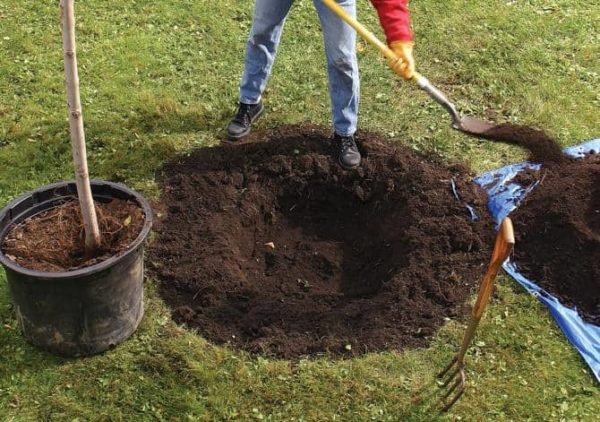 Dig the whole garden or garden in the fall. All weed grass must be removed from the site.
Dig the whole garden or garden in the fall. All weed grass must be removed from the site.
Walkthrough:
- After choosing a seat, dig a hole 50 cm by 50 cm and 60 cm deep.
- They dig a hole two days before planting a tree.
- Sand and drainage are poured at the bottom, a stake is driven into the center, for which a seedling will be tied.
- The gap is left between adjacent plants 3 meters.
- Part of the excavated soil is mixed with fertilizers and put back into the hole.
- A mound is made, a seedling is placed, spreading its roots so that the vaccine is 3 cm above ground level.
- From the stake to the barrel, the distance is 5-7 cm.
- Having fallen asleep with earth, they are lightly tamped, watered 8-10 l with plenty of water.
- Top cover with mulch - hay, sawdust, peat. This will save the fruit plant from freezing.
If it is not immediately possible to plant a plum in the fall in a permanent place, then the tree is dug up obliquely. Fully covered with earth and peat, you can use foliage for insulation. In the spring, the seedling is transplanted to a new place.
Care after landing
Careful care will prepare the young for wintering, it will not freeze. They carry out the main activities that help strengthen the roots, in the future receive stable crops and protect the plant from harmful insects and diseases.
Pruning
Autumn crown pruning is done in the first half of September. If you cut the branches later, the tree will not be able to recover to the cold. Circumcision forms the future crown. When they leave long shoots, they can break from the wind.
Pruning process:
- At the first pruning, the branches are cut 1/3.
- Fast-growing branches are shortened by 2/3.
- Dry, diseased shoots are removed.
Use a sharp secateurs and gloves. Without the formation of the crown, there will be no beautiful flowering appearance next year. Use a simple cropping scheme.
Disease prevention
Most often, plums suffer from gray rot and holey spotting. Yellow spots with brown border appear on the leaves. Then holes appear, the fruits crack, rot. After falling leaves, the trees can be treated with Bordeaux liquid (3%). Processing is repeated in the spring until flowering.
Whitewashing trees
In winter, the trunk is better to whitewash with a solution of lime. This will help the tree survive the frosts and temperature changes. The recipe for a solution: 3 kg of lime, 2 kg of clay are diluted in a bucket of water. Stir thoroughly, paint brush dipped in lime and cover the trunk with it.
Pest protection
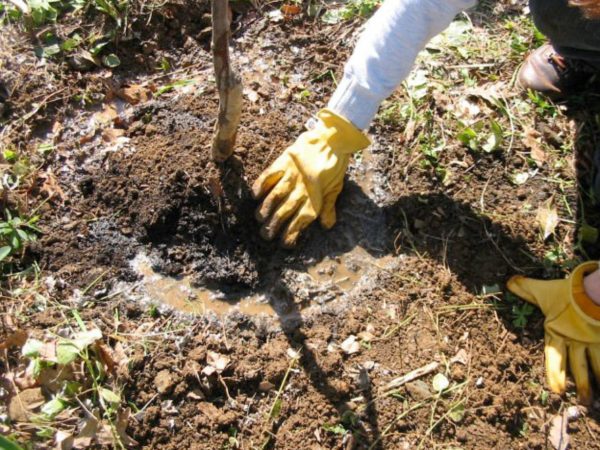 Plum aphid, goose, fruit tick, black ants annoy plum. As a preventive measure, tincture of wormwood, onion peel, garlic and soap is used.
Plum aphid, goose, fruit tick, black ants annoy plum. As a preventive measure, tincture of wormwood, onion peel, garlic and soap is used.
Recipes:
- One liter of boiling water is poured into a container and a full liter jar of onion husks is poured there. Leave for 48 hours. Filter before filtering, then dilute with water 1: 2.
- 6 cloves of garlic are poured with a liter of water, insist 24 hours. Before use, add 6 g of households. soap.
- Ash water is prepared (a glass of ash in 9 liters of water), 6-7 cloves of chopped garlic are added, mixed, insisted for 5 hours. Make 1 tablet of micronutrient fertilizers and 50 g of mineral additives, spray the plants with the product.
- With a strong invasion of insects, the crown is treated with a urea solution of 5%. All branches are sprayed.
Fertilizer
If the landing was done according to all the rules, then the first year of life the drain will have enough food and it does not need additional fertilizing. In the spring, fertilize with urea 25 g per square meter. The first top dressing is carried out in the fall for 2 years of life.
Watering
The root system of plums is close to the surface of the earth. If the groundwater lies deep, then the earth is moistened up to 1 m deep.Before the winter, if it was a dry summer, in September every young plant is watered abundantly: 4-5 buckets per instance. Watering is necessary for better wintering. If in September there was a lot of rainfall, then watering should be abandoned. Do not forget to make drainage grooves so that rainwater does not accumulate in the landing pit.
Winter preparations
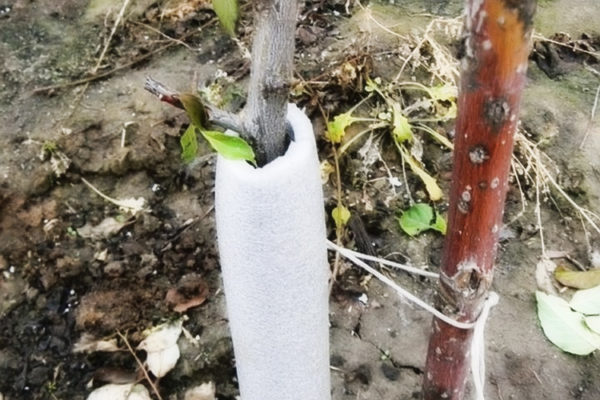 Before winter, the soil is loosened, all weeds are removed. A fragile tree may not survive severe frosts. If severe frosts are expected, then the seedling is covered with fir branches or surrounded by poles, forming a hut. Top impose straw, hay, sedge. Then fix the structure with a rope. Such a shelter to protect not only from the cold, but also from the wind, the sun.
Before winter, the soil is loosened, all weeds are removed. A fragile tree may not survive severe frosts. If severe frosts are expected, then the seedling is covered with fir branches or surrounded by poles, forming a hut. Top impose straw, hay, sedge. Then fix the structure with a rope. Such a shelter to protect not only from the cold, but also from the wind, the sun.
Mulch the surface of the soil with sawdust, hay, peat. To prevent rodents from stripping the bark, sprigs of mint are inserted into the hut.
If no cover is provided, and winter is snowy, shields are placed around the tree. When the snow falls, it will not be blown away by the wind. A large snow layer will insulate and give moisture to the roots. If the snow layer is more than 60 cm, then it is reduced.
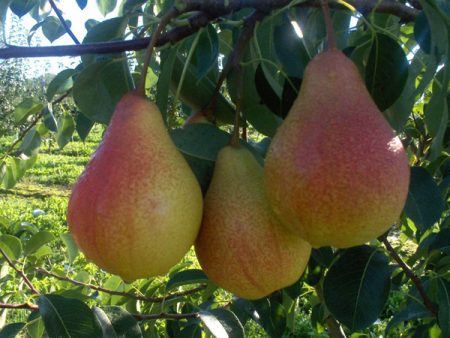 You may be interested in:
You may be interested in:When to plant plum in spring or autumn
Both methods have their advantages. But the autumn landing in this is superior to the spring. The main advantages of the fall landing:
- plants are less sensitive to damage;
- soil is compacted during the spill of buds in spring;
- with spring activation there is no effect on the tree, it has already taken root;
- fresh material for planting;
- the fruits appear earlier than the spring seedling.
It is important that the tree removed in the fall from the nursery was delivered after the cessation of vegetation. And spring material was disturbed during the period of kidney swelling. In the autumn plum, the root system will not experience stress. There is a minus - you can never predict the weather in winter. In severe frost, a young plant may die.
If the ripped trees were not sold immediately in the spring, then activation of buds and growth may begin before planting in the soil. When spring planting, young growth must be pre-soaked, it takes time. Therefore, when to plant a fruit tree it's up to you.
Features landing in the regions
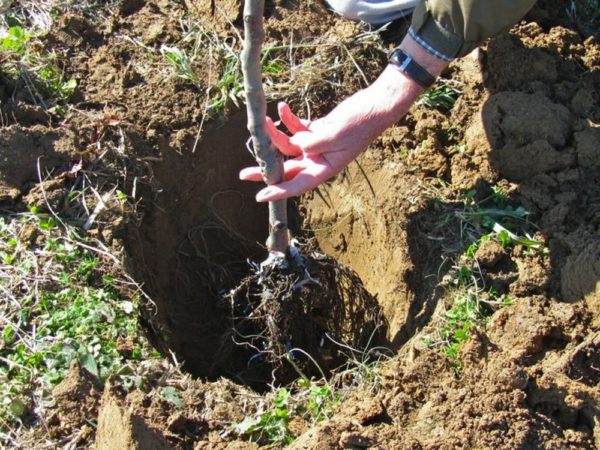 The choice of a zoned hybrid that is resistant to weather conditions characteristic of such an area will make it possible to obtain tasty fruits in the future and give good yield indicators.
The choice of a zoned hybrid that is resistant to weather conditions characteristic of such an area will make it possible to obtain tasty fruits in the future and give good yield indicators.
In the Volga region and the middle zone
Winters are not very frosty in these areas. They plant trees in mid-September. Preference is given to varieties resistant to clasterosporiosis and moniliosis. Plum is best planted on the south side of the site on light loamy soils.
In the Siberian region and in the Ural region
In the Siberian Territory and in the Urals, it is not recommended to plant plums in autumn, frosts begin early. Only zoned and winter-hardy varieties are used.
You can plant a seedling in a bucket and transfer to the basement, the temperature should not fall below 3-5 degrees below zero. Do not forget to water the plant, make additional lighting. And in late April, it is better to transplant the plum to a permanent place.
Possible errors when planting a plum
No one is immune from mistakes when planting autumn seedlings. Even experienced gardeners can make mistakes.
The main errors when planting a plum:
- Plant a plum in the fall at an angle. This is not worth it, the wind can break the seedling.
- Fearing that little fertilizer is applied, they are trying to do additional fertilizing. Overfeeding of plants is dangerous for young animals.
- Abundant watering can lead to rotting of the rhizome, or freezing in early frosts.
- Do not include varieties for this area.
With proper transplantation and further care, after a few years, the plum will delight you with a plentiful harvest.The first year is most important for further plum growth. If a tree calmly overwinters and takes root, then its development depends on watering, top dressing, protection from insects and diseases, preparation for winter.
